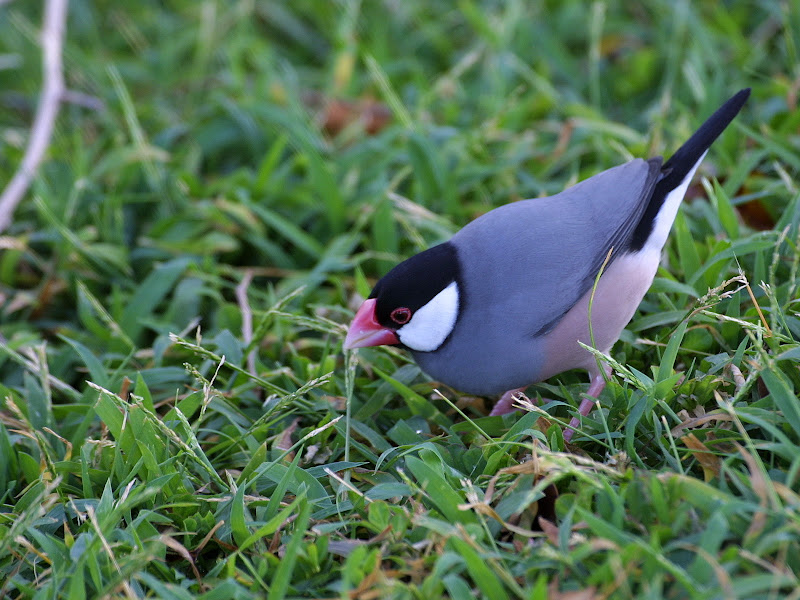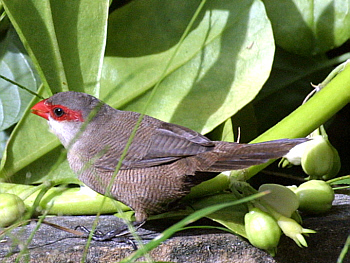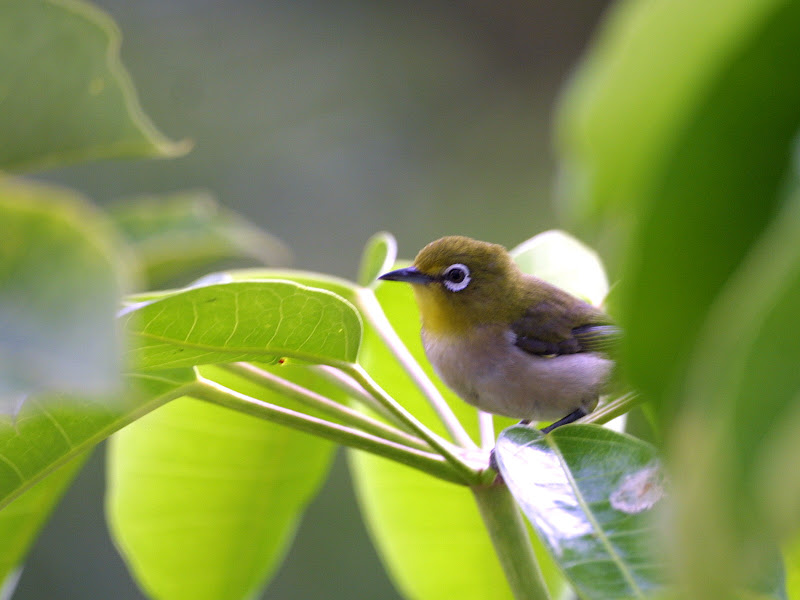 [Java Sparrow]
[Java Sparrow]My favorite bird of Hawaii. These little guys are populous and have a fun personality. They gather in small groups of 5-20 birds and feed on the ground in the grass or at feeders. They have big white patches on their cheeks and they make a "chippering" sounds as they communicate with each other. They are very social and competitive, arguing fiercely over food if it is found in a feeder. When feeding in the wild on grasses, they are cooperative and will not fight over their food.
They are more trusting of humans than Myna birds, but not very much. I had a feeder and they would allow me to view them from a few feet away.
 [Red Crested Cardinal]
[Red Crested Cardinal]These birds look like they are wearing a red hood. They are social birds that can be seen in pairs almost anywhere in Hawaii. They move quickly, darting like road runners across the ground looking for food. In the morning and in the evening, their song is a four-part song: chirp, chireeirp (or cheeryup), churp, choo. It is relaxing and pleasing to hear like the Zebra Dove. During the day, they use only one or two of the song parts in general.
These birds are more aggressive than the Zebra Dove, and they will swoop in and grab food that is very close to a person but I have not seen them eat out of a person's hand. When their colors are strong, they are very beautiful birds, and their heads look like flames leaping out of the grass.
 [Myna]
[Myna]Myna birds are populous in Hawaii. There are literally thousands and thousands of them, and most people consider them a pest, but I love them. They are very gregarious, and they make noise from sunrise to sunset. They can be found in pairs or small groups, hopping around scavenging for food almost everywhere.
They are very funny birds to watch because of their mannerisms. I have found that they do not pay humans much attention unless the human attends to them. People can walk past them and they will just continue on their business, but if you stop to look at them, they will get nervous, give a small squeak and fly off. They are loud, calling to each other almost continuously with a wide vocabulary. Some people have even taught them to speak in captivity.
They are not the most beautiful bird, but they are one of my favorites because they are so entertaining. In the evening, they will gather in small groups to talk about the day. During these "conversations" they will often fluff their head feathers up and nod their heads toward the ground as if in agreement about the day's events.
Mynas will never let you feed them. If a mixed group of birds are feeding on pretzels or something like that and a person is near, the mynas will maintain a wide radius, waiting for the person to leave. Once the person moves away, the mynas will swoop in and bully the other birds out of the way, flying off with the choice pieces, screeching at each other the entire time.
 [Zebra Dove]
[Zebra Dove]Zebra doves are also quite populous in Hawaii. They can be found singly or in small groups of up to 10. If fed, they will cluster and gather into large groups of possibly 50. They are gentle birds, and very trusting of people, often to their own detriment because they get smashed by cars quite frequently. They have a lovely cooing song that is very pleasing and relaxing to hear. It is what a bird would sound like if they could purr like a cat.
Because they are so trusting of people, it is easy to get very close to them. I have fed them from my hand on several occasions. They are not aggressive, although they will have small competitions for food.
 [Golden Plover (Kolea)]
[Golden Plover (Kolea)]One of the few migratory birds of Hawaii, they are beautiful birds that arrive on the islands in September and stay until April, when they leave to migrate to Alaska. They are generally silent and solitary birds, only crying when they are startled by another bird or a person. Each bird stakes out a piece of ground and feeds on grubs and other insects. They return to nearly the same ground every year.
They are amazing fliers, as evidenced by their yearly migration, but they prefer to feed on the ground and will not generally fly about unless they are startled.
One of the most amazing things about these birds is the transformation the males make before their departure for Alaska. In the weeks prior to their flight, the mature males' feathers in front turn pure black, and they look as though they are wearing a tuxedo. It is very dramatic. Birds of each sex fatten up prior to their departure and when it is time to depart, they circle upward several thousand feet and fly north at up to 50kph. The flight, depending on the path taken, takes about 90 hours.
 [Tern]
[Tern]These beautiful birds are not as common as some of the other birds in Hawaii. They can be found in pairs, and their pure white plumage is blinding when viewed in direct sunlight. I do not have much experience with these birds, although one time when I was out for a run, a pair of them flew and circled near me, swooping to the side of me. It seemed like they were "running" with me for a few blocks, and then they moved on. One of them flew for a couple seconds right next to me, and I could see into its eyes, which were mirror black.
This play behavior I have also noticed in other pairs. I have seen them riding the drafts between the tall buildings in Honolulu.
 [Common Waxbill]
[Common Waxbill]This tiny bird congregates in groups of 20-40 birds on the grass during the day. They are very tiny, one could fit in a shot glass. Their song is very high pitched squeaking which is funny to hear when they all fly off at once due to some fright. They are pretty to look at and sometimes have very bright red colors.
 [White-Rumped Shama]
[White-Rumped Shama]I have only seen this bird once when I heard a song I had not heard before and I waited to find the source. I saw this bird about 50 feet up in a tree, and it is the only time I have seen one.
 [Japanese White-Eye (Mejiro)]
[Japanese White-Eye (Mejiro)]se tiny birds are sometimes difficult to find, but you can find them regularly if you know where to look. They can be found in small bushes near buildings and near the base of trees when they think no one is looking. The Mejiro is known as a nuisance bird in Japan, because they steal rice from the farmers there. They are small and skittish, hopping from branch to branch in search of food.

